| Author |
Message |
|
|
| |
Post subject: |
Re: 1/700 HMAS Canberra, Aug 9, 1942– Battle of Savo Island |
 |
|
Thank you! I had to take this chance - how often can you really make your model more precise after it was completed? And this was not too difficult in the end  Happy modelling! Thank you!
I had to take this chance - how often can you really make your model more precise after it was completed? And this was not too difficult in the end ;)
Happy modelling!
|
|
|
 |
Posted: Sat May 04, 2019 11:22 am |
|
|
 |
|
|
| |
Post subject: |
Re: 1/700 HMAS Canberra, Aug 9, 1942– Battle of Savo Island |
 |
|
|
|
|
 |
Posted: Sat May 04, 2019 8:50 am |
|
|
 |
|
|
| |
Post subject: |
Re: 1/700 HMAS Canberra, Aug 9, 1942– Battle of Savo Island |
 |
|
|
It's these types of details that bring these models to life. Well done!
It's these types of details that bring these models to life. Well done!
|
|
|
 |
Posted: Sat May 04, 2019 6:30 am |
|
|
 |
|
|
| |
Post subject: |
Re: 1/700 HMAS Canberra, Aug 9, 1942– Battle of Savo Island |
 |
|
|
What a fantastic detail to notice!
What a fantastic detail to notice!
|
|
|
 |
Posted: Fri May 03, 2019 7:28 am |
|
|
 |
|
|
| |
Post subject: |
Quad Vickers MG on HMAS Canberra in August 1942 |
 |
|
I never thought I might have something more to add to this thread... never say (think  ) never! Chuck Haberlein, naval historian and participant in the 1992 Iron Bottom Sound explorations, made a post in the Facebook Cruisers group some three months ago about what they saw during their dives to the wreck of HMAS Canberra. I contacted him and he kindly sent me his report on their findings. We also discussed the issue of Canberra´s likely fatal damage by 1-2 torpedoes from USS Bagley as first postulated in „The Shame of Savo“ book by survivor of HMAS Canberra Commodore Bruce Loxton (Royal Australian Navy, Retired), then a midshipman. Unfortunately, Chuck was not able to confirm this hypothesis during their dive. They did not explore torpedo damage of the ship because the book only appeared 2 years later in 1994. However, Chuck shared with me his rememberances of meeting Commodore Loxton: „At the beginning of our discussions, one of the RAN attaches at their embassy in Washington brought Commodore Loxton over to my house (a short distance outside Washington, D.C., in Northern Virginia), where we spent an entertaining evening reviewing the dive tapes made on Canberra. At one point, he commented that all the ship's quadruple .50 caliber anti-aircraft machine guns had been removed when 20mm guns were installed. I told him that wasn't the case, and he replied that he'd been on the ship, and I hadn't. So, as the scene passed along the starboard side main deck aft of the torpedo flat, I got a chance for a little fun. As one of those quad .50cal. mounts came into view, I innocently inquired "what's that?" and Loxton replied "You've made your point. Move on!". This was really unexpected news to me as I never heard about quad MG onboard Canberra after her May 1942 refit, nor did I notice the mount on any of her photos. Chuck then explained: “That quad .50 was on the starboard main deck, roughly abreast of the aircraft crane. It was the only mount of that type that I remember seeing on Canberra's wreck. If I recall correctly, the positions just aft of the bridge structure (one on each side of the ship) had been reequipped with 20mm guns, which was the basis for Loxton believing that all .50s had been removed. Since his battle station was on the bridge, judging by what he wrote of the battle in his book, he might have been more familiar with those 20mms, and either not noticed, or not remembered the .50 quad that had been moved further aft.“ Unfortunately, Chuck was not at liberty to share videos or screen shots. But the starboard quad was also depicted on Chuck´s sketch of the sunken Canberra he made based on the videotapes: Attachment:
 Canberra wreck sketch courtesy of Chuck Haberlain_m.jpg [ 122.15 KiB | Viewed 4010 times ]
Canberra wreck sketch courtesy of Chuck Haberlain_m.jpg [ 122.15 KiB | Viewed 4010 times ]
I examined my photo collection of Canberra but was once again not succesful in finding the mount. I then shared the story with Brett Morrow, fellow researcher who helped me a lot with my Canberra build. Couple of days later Brett approached me and pointed out the port mount he identified on the famous photo of Canberra leaving Wellington on July 22, 1942 (NHHC 80-G-13454-A) and on one of the dazzle camouflaged photos from May 1942: Attachment:
 CANBERRA Port quad_m.jpg [ 155.09 KiB | Viewed 4010 times ]
CANBERRA Port quad_m.jpg [ 155.09 KiB | Viewed 4010 times ]
I then returned to my photos and finally located the same familiar shape of the starboard mount on another well-famous photo of the stricken cruiser – very close to the place described by Chuck and opposite to the port position noticed by Brett. It´s really interesting what can be found on the same photos one´s seen over and over for so many times! Attachment:
 CANBERRA Stbd quad_m.jpg [ 181.81 KiB | Viewed 4010 times ]
CANBERRA Stbd quad_m.jpg [ 181.81 KiB | Viewed 4010 times ]
I consider it confirmed that these quad machine guns were present on Canberra during the Battle of Savo Island. As the intention of my Canberra build was to show her as close as possible to how she looked like that fateful night, I added the two quads (Fine Molds) along with scratchbuilt splinter shields made from leftover photo-etched brass. There were several types of shields in use in WW2 so I modeled mine according to those used on other RAN ships (HMAS Perth and HMAS Warrego) in 1942. I also added partitions adjacent to these guns as shown below. Big thanks to Chuck, Brett and Commodore Bruce Loxton, the top inspirator of my modeling and research activities in the past couple of years!   I never thought I might have something more to add to this thread... never say (think :) ) never!
Chuck Haberlein, naval historian and participant in the 1992 Iron Bottom Sound explorations, made a post in the Facebook Cruisers group some three months ago about what they saw during their dives to the wreck of HMAS Canberra. I contacted him and he kindly sent me his report on their findings. We also discussed the issue of Canberra´s likely fatal damage by 1-2 torpedoes from USS Bagley as first postulated in „The Shame of Savo“ book by survivor of HMAS Canberra Commodore Bruce Loxton (Royal Australian Navy, Retired), then a midshipman. Unfortunately, Chuck was not able to confirm this hypothesis during their dive. They did not explore torpedo damage of the ship because the book only appeared 2 years later in 1994. However, Chuck shared with me his rememberances of meeting Commodore Loxton:
„At the beginning of our discussions, one of the RAN attaches at their embassy in Washington brought Commodore Loxton over to my house (a short distance outside Washington, D.C., in Northern Virginia), where we spent an entertaining evening reviewing the dive tapes made on Canberra. At one point, he commented that all the ship's quadruple .50 caliber anti-aircraft machine guns had been removed when 20mm guns were installed. I told him that wasn't the case, and he replied that he'd been on the ship, and I hadn't. So, as the scene passed along the starboard side main deck aft of the torpedo flat, I got a chance for a little fun. As one of those quad .50cal. mounts came into view, I innocently inquired "what's that?" and Loxton replied "You've made your point. Move on!".
This was really unexpected news to me as I never heard about quad MG onboard Canberra after her May 1942 refit, nor did I notice the mount on any of her photos.
Chuck then explained: “That quad .50 was on the starboard main deck, roughly abreast of the aircraft crane. It was the only mount of that type that I remember seeing on Canberra's wreck. If I recall correctly, the positions just aft of the bridge structure (one on each side of the ship) had been reequipped with 20mm guns, which was the basis for Loxton believing that all .50s had been removed. Since his battle station was on the bridge, judging by what he wrote of the battle in his book, he might have been more familiar with those 20mms, and either not noticed, or not remembered the .50 quad that had been moved further aft.“
Unfortunately, Chuck was not at liberty to share videos or screen shots. But the starboard quad was also depicted on Chuck´s sketch of the sunken Canberra he made based on the videotapes:
[attachment=0]Canberra wreck sketch courtesy of Chuck Haberlain_m.jpg[/attachment]
I examined my photo collection of Canberra but was once again not succesful in finding the mount. I then shared the story with Brett Morrow, fellow researcher who helped me a lot with my Canberra build. Couple of days later Brett approached me and pointed out the port mount he identified on the famous photo of Canberra leaving Wellington on July 22, 1942 (NHHC 80-G-13454-A) and on one of the dazzle camouflaged photos from May 1942:
[attachment=2]CANBERRA Port quad_m.jpg[/attachment]
I then returned to my photos and finally located the same familiar shape of the starboard mount on another well-famous photo of the stricken cruiser – very close to the place described by Chuck and opposite to the port position noticed by Brett. It´s really interesting what can be found on the same photos one´s seen over and over for so many times!
[attachment=1]CANBERRA Stbd quad_m.jpg[/attachment]
I consider it confirmed that these quad machine guns were present on Canberra during the Battle of Savo Island. As the intention of my Canberra build was to show her as close as possible to how she looked like that fateful night, I added the two quads (Fine Molds) along with scratchbuilt splinter shields made from leftover photo-etched brass. There were several types of shields in use in WW2 so I modeled mine according to those used on other RAN ships (HMAS Perth and HMAS Warrego) in 1942. I also added partitions adjacent to these guns as shown below.
Big thanks to Chuck, Brett and Commodore Bruce Loxton, the top inspirator of my modeling and research activities in the past couple of years!
[url=https://flic.kr/p/TCsJq3][img]https://live.staticflickr.com/65535/33886804618_c0735d3df9_c.jpg[/img][/url]
[url=https://flic.kr/p/S1djhK][img]https://live.staticflickr.com/65535/32820241267_b56d21d71e_c.jpg[/img][/url]
|
|
|
 |
Posted: Fri May 03, 2019 7:15 am |
|
|
 |
|
|
| |
Post subject: |
Re: 1/700 HMAS Canberra, Aug 9, 1942– Battle of Savo Island |
 |
|
Beautifull.....!   Beautifull.....! :thumbs_up_1: :thumbs_up_1:
|
|
|
 |
Posted: Sat Aug 26, 2017 3:35 am |
|
|
 |
|
|
| |
Post subject: |
Re: 1/700 HMAS Canberra, Aug 9, 1942– Battle of Savo Island |
 |
|
Thank you all! I added these two photos to Flickr later and now made them b&w, I thought you may like them, too. I imagined it´s after midnight, August 9th, Captain Getting just retired to his sea cabin and Canberra in the second degree of readiness, lookouts on the bridge, half of the gun positions in an alert state - and their fate just under the horizon... 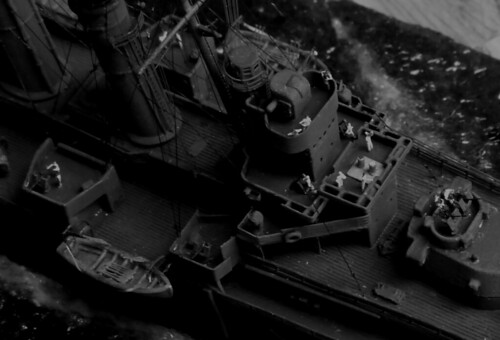  Thank you all!
I added these two photos to Flickr later and now made them b&w, I thought you may like them, too.
I imagined it´s after midnight, August 9th, Captain Getting just retired to his sea cabin and Canberra in the second degree of readiness, lookouts on the bridge, half of the gun positions in an alert state - and their fate just under the horizon...
[url=https://flic.kr/p/WkFSuN][img]https://farm5.staticflickr.com/4369/35666058134_d6a9101e11.jpg[/img][/url] [url=https://flic.kr/p/Xxo1VJ][img]https://farm5.staticflickr.com/4333/36454729196_dfd21c40c8.jpg[/img][/url]
|
|
|
 |
Posted: Fri Aug 11, 2017 8:46 am |
|
|
 |
|
|
| |
Post subject: |
Re: 1/700 HMAS Canberra, Aug 9, 1942– Battle of Savo Island |
 |
|
Awesome  Awesome :woo_hoo:
|
|
|
 |
Posted: Thu Aug 10, 2017 3:23 pm |
|
|
 |
|
|
| |
Post subject: |
Re: 1/700 HMAS Canberra, Aug 9, 1942– Battle of Savo Island |
 |
|
As I said on Facebook this is just lovely well done  As I said on Facebook this is just lovely well done :)
|
|
|
 |
Posted: Thu Aug 10, 2017 2:27 am |
|
|
 |
|
|
| |
Post subject: |
Re: 1/700 HMAS Canberra, Aug 9, 1942– Battle of Savo Island |
 |
|
|
It has already been said but this is truly inspiring modelling!
Many thanks for sharing.
Cheers
It has already been said but this is truly inspiring modelling!
Many thanks for sharing.
Cheers
|
|
|
 |
Posted: Wed Aug 09, 2017 5:01 am |
|
|
 |
|
|
| |
Post subject: |
Re: 1/700 HMAS Canberra, Aug 9, 1942– Battle of Savo Island |
 |
|
Wow, a really great and inspiring build  . Greetings Christian Wow, a really great and inspiring build :thumbs_up_1: .
Greetings Christian
|
|
|
 |
Posted: Tue Aug 08, 2017 1:52 am |
|
|
 |
|
|
| |
Post subject: |
Re: 1/700 HMAS Canberra, Aug 9, 1942– Battle of Savo Island |
 |
|
|
Thank you, Dan!
It was a great experience. I was able to collect over 60 photographs, some of them really hi-res, and although most of them were pre-war they provided very good reference for the kit as she was not modified too much. Also some excellent pre-modification shots of Australia, even a few overhead. I think that happens quite rarely that a WW2 ship lost early in the war had been so extensively photographed and these photos were available on the net. On the other hand only a few 1942 photos are available so some guessing was needed.
Thank you, Dan!
It was a great experience. I was able to collect over 60 photographs, some of them really hi-res, and although most of them were pre-war they provided very good reference for the kit as she was not modified too much. Also some excellent pre-modification shots of Australia, even a few overhead. I think that happens quite rarely that a WW2 ship lost early in the war had been so extensively photographed and these photos were available on the net. On the other hand only a few 1942 photos are available so some guessing was needed.
|
|
|
 |
Posted: Tue Aug 08, 2017 1:00 am |
|
|
 |
|
|
| |
Post subject: |
Re: 1/700 HMAS Canberra, Aug 9, 1942– Battle of Savo Island |
 |
|
|
Yes, she is beautifully done. I do sense that you had fun on the project.
Yes, she is beautifully done. I do sense that you had fun on the project.
|
|
|
 |
Posted: Mon Aug 07, 2017 12:51 pm |
|
|
 |
|
|
| |
Post subject: |
Re: 1/700 HMAS Canberra, Aug 9, 1942– Battle of Savo Island |
 |
|
Thank you very much, Jon and Martin, that´s very kind of you! I had much fun building her  Thank you very much, Jon and Martin, that´s very kind of you! I had much fun building her :)
|
|
|
 |
Posted: Mon Aug 07, 2017 12:08 pm |
|
|
 |
|
|
| |
Post subject: |
Re: 1/700 HMAS Canberra, Aug 9, 1942– Battle of Savo Island |
 |
|
|
That is a very impressive piece of modeling. Well done - she looks great!!
That is a very impressive piece of modeling. Well done - she looks great!!
|
|
|
 |
Posted: Mon Aug 07, 2017 10:02 am |
|
|
 |
|
|
| |
Post subject: |
Re: 1/700 HMAS Canberra, Aug 9, 1942– Battle of Savo Island |
 |
|
Wonderful build! Well done.  Wonderful build! Well done. :thumbs_up_1:
|
|
|
 |
Posted: Mon Aug 07, 2017 9:41 am |
|
|
 |
|
|
| |
Post subject: |
1/700 HMAS Canberra, Aug 9, 1942– Battle of Savo Island |
 |
|

75 years ago, the heavy cruiser HMAS Canberra lead the Southern Group of Allied heavy cruisers on guard off the invasion harbour at Guadalcanal after midnight on August 9, 1942, when she became the first target of a column of seven Japanese cruisers “crossing the T” of the Allies. She maneuvered violently to starboard but before she was able to fire her guns she was hit in a quick succession by at least 27 heavy Japanese shells to port and by 2 torpedoes to starboard, fired most probably by USS Bagley. Left burning without steam she was scuttled by US destroyers the next morning.The biggest challenge in building Canberra at Savo Island is the largely incomplete reference about her final fit in summer 1942. There are many excellent, hi-res photos available on the internet from various stages of her and her sister´s pre-war careers but only handful photos mostly of mediocre quality showing her from May 1942 onwards, and none of them taken from above. I tried my best in finding more resources but even with a great help from RAN specialists Brett Morrow and Michael Brown it was not possible to resolve with certainty all of the issues that emerged. Nevertheless, I tried to make my Canberra appear as close to photos available as I could while keeping the amount of speculation at the unavoidable minimum. 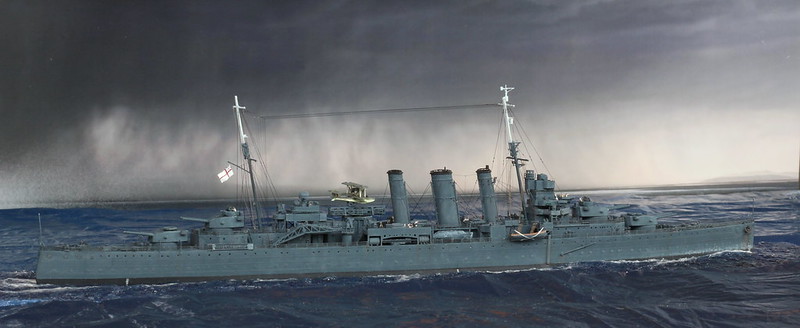 The famous photo of Canberra leaving Wellington for her last voyage on the Combrig box seemed to suggest the kit represented her as-lost fit. In reality, the kit is a mixture of how various parts of Canberra looked like in various periods of her career, mostly resembling her early war (from 1938 till her 1942 refit) fit. As a result, modifications are needed to depict Canberra at any moment of her career, but the kit can be also used for HMAS Australia before 1939 because they were almost identical until then (there is a separate Combrig kit for Australia after her 1939 refit, sharing the same hull and a few other parts). 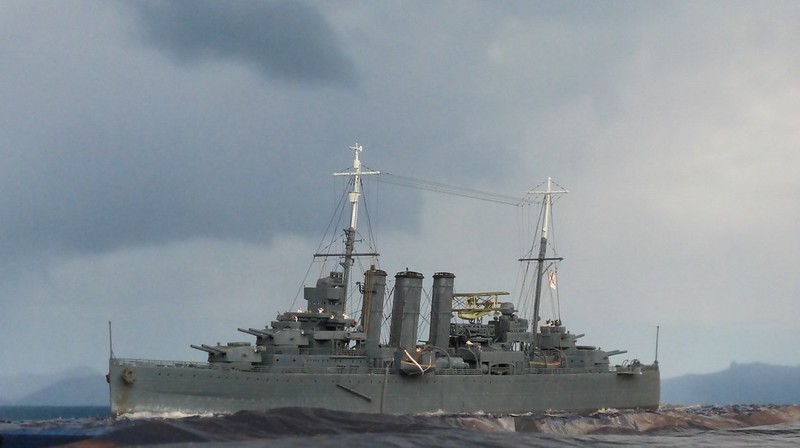 She was also my first resin kit – not a bad one to start with but none of the easiest, so another challenge for me. To my surprise, I did not find prepping resin parts to be of a particular problem, but there were other issues of course. First of all there is the known issue mentioned e.g. by Norbert Thiel that the deck aft of the X turret is noticeably sloped upwards while it should be parallel to the waterline – thanks to Jon Iverson for explaining me how to correct this! The kit details in general are quite good, but the main turrets looked quite weird and far too simplified. When I was in the middle of my build I noticed the mid funnel´s cross-section was really wrong (too long & too narrow) so it made me taking my first steps in designing parts for 3D printing, of which I took advantage also in creating modified 20mm gun platforms on the side of the funnel. Finally, when I was very near to start spraying her I realized there was something wrong about the shape of her bow, too – it should be straight (not curved) and more vertical. Two pieces of sheet styrene and a lot of sanding made for it.   The hull shows Canberra´s lower level of portholes open but these were plated over and her side chutes were moved forward in early 1942, when also her midship gun platforms were modified and 20mm guns added on top of them. 20mm tubs for tops of turrets B and X are included in the kit, but these are too small and incorrectly shaped as each of them should carry two Oerlikon guns instead of one. One of them can nevertheless be used for the single Oerlikon bin on the quarterdeck. The kit´s bridge is most similar to its original appearance before it was modified in ca 1930. Indeed, it also lacks the Type 271 radar lantern that she received in early 1942. 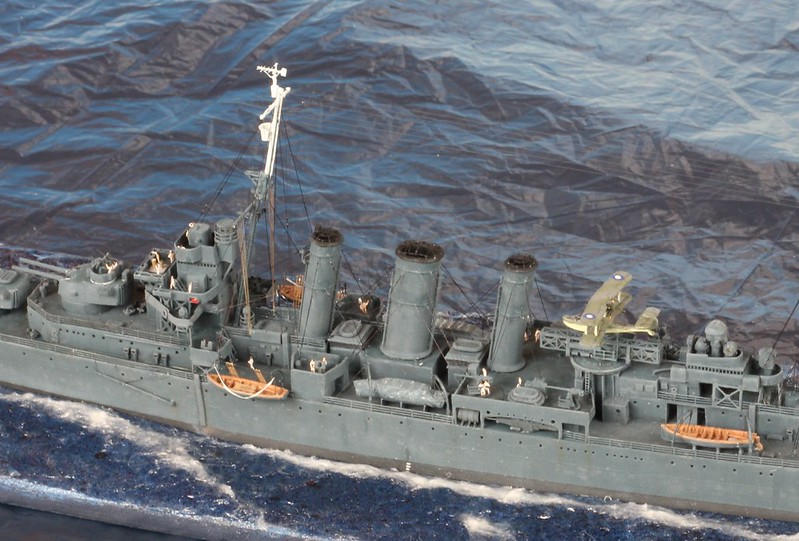 Here´s a summary of other more important modifications and replacements in my build: Hull & deck• Only two anchors in place, the second starboard hawse pipe plated over • Quarterdeck rearranged according to photos (the original resembled more Australia´s than Canberra´s), added accommodation ladders, single 20mm gun tub, PE depth charge rack and smoke generators • Numerous small deck vents have been added as well as slightly larger vents attached to the superstructure (my own 3D printed models) Main bridge• Bridge „wings“ at level 2 cut narrower, their solid sides replaced by PE railings covered by PVA glue for “canvas” • Wind baffles added to bridge level 3 • Top bridge level scratchbuilt to include large rounded lookouts typical for the ship´s appearance after 1930 • Type 271 radar housing with octagonal „lantern“ added to the back side (parts from LionRoar RN Radar PE set and scratchbuilt) • Various supports added  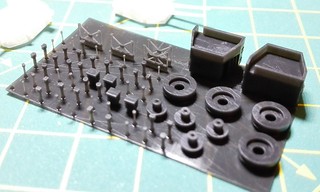 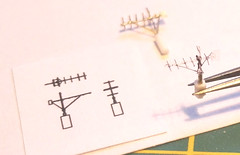 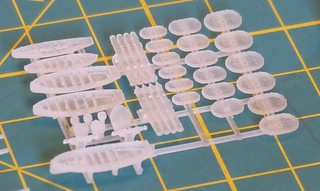 Superstructure Superstructure• Aft bridge – smaller superstructure parts added in the walk-through one level below and under the bridge, modified with various PE parts • 8“ turrets, HACS director aft, searchlights, uncovered boats, torpedo tubes and Carley floats replaced with 3D printed by Micro Master – see here for more details• 8” gun barrels replaced with turned brass (NNT) • 4“ and 20mm gun mounts replaced with 3Dmodelparts, 4” barrels replaced with turned brass and 20mm guns by Flyhawk PE • Funnels, midships 20mm gun platforms and pressure tanks at the torpedo deck replaced with my own 3D printed models • WEM County-class PE set used for crane, catapult and some other minor parts; PE from LionRoar, Gold Medal, Flyhawk and Rainbow used for railings, doors, hatches, davits, funnel grills etc. • Masts replaced with soldered brass • Type A290 radar (scratchbuilt) on the foremast (there is a story of its own about this almost unknown early radar set locally built in Australia) 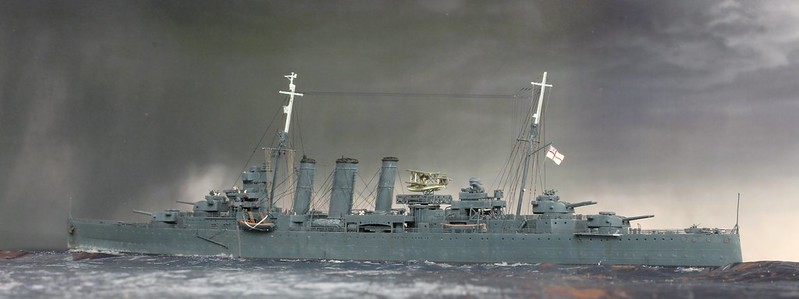 Paint scheme Paint schemeAnother interesting research concerned colours worn into her final battle. It turned out she probably carried three (!) different colour schemes within the few weeks of emerging from her refit in May 1942 till loss. According to the latest research by Michael Brown her vertical surfaces were painted USN 5-N Navy Blue with original paint from paint lockers of USS Chicago. Mast tops were painted RAAF Sky Blue K3/195. We found no evidence about colour of her horizontal surfaces, however I consider highly unlikely that her decks were left bare wood in a situation of imminent Japanese aerial attacks. More obvious choice would have been 507A which e.g. Australia wore at Coral Sea, so I guess that was how Canberra´s decks were likely painted after her May refit and she might have carried it over to the Solomons. However, as the main reason for using 5-N on vertical surfaces was to put her (and Australia and Hobart) in line with US ships in the Task Force, it would seem logical that USN 20-B Deck Blue was used for horizontal surfaces, and I have chosen this option. I know it may be found controversial, but until more evidence is discovered I think this option is as likely as any other. Edit 24.2.2020: I would now consider more correct to use 507A for her topside colours instead of 20-B. Also check my USS Chicago build for my thoughts about her early 1942 vertical colour that might have consequences for RAN ships.I used Lifecolor paints and I did the weathering with diluted artist´s oil paints. 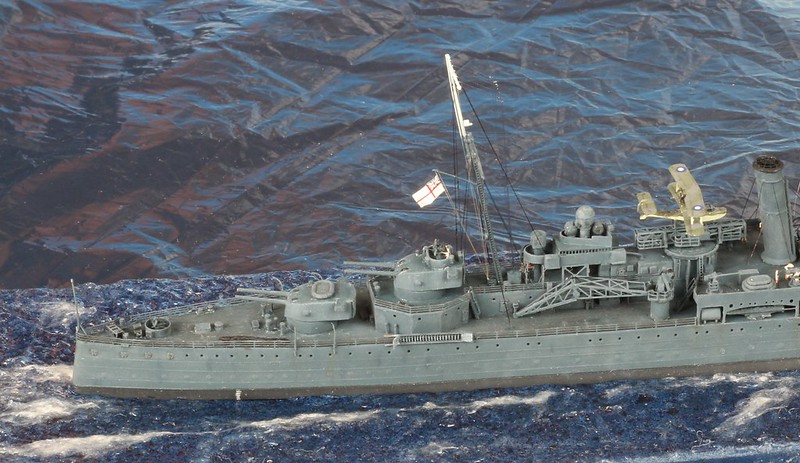 My Canberra´s Supermarine Walrus comes from Flyhawk 1/700 WW2 British Royal Navy Aircraft II and sports a 3-colour Temperate Sea scheme (Extra Dark Sea Grey, Dark Slate Grey, Sky) with no shadow-shading. Insignia centres were painted over with white on upper wings and yellow surround was painted over on fuselage sides.  Canberra´s extensive rigging was done by 0.06mm fishing line for the thicker rigging (standing wires, funnel supports etc.) and UNI Caenis 20 den monofilament, black for antennae and white stained with medium brown acrylic marker for halliards. I am not sure what I enjoyed more – the build itself or the all research and discussions with fellow enthusiasts, but it was probably the latter. I am happy I was able to finish her just in time for the 75th anniversary of her sinking, so I dedicate my build to the memory of all souls lost in the battle. References• Modelwarships.com: Calling all RN County class fans thread • Pre-war and wartime photography from various online sources, especially Naval History and Heritage Command, Australian War Memorial, Imperial War Museum and Horatio J. Kookaburra profile on Flickr• Primary documents from the National Archives of Australia researched by Michael Brown • Slawomir Brzezinski: British heavy cruiser HMS KENT (Profile Morskie No. 77) • Bruce Loxton: The Shame of Savo: Anatomy of a Naval Disaster SPECIAL THANKS TO• First of all - Brett Morrow for all his research, opinion and advice, prompt and friendly replies to my never-ending stream of questions and for keeping me up at times when I got stuck or down • Michael Brown for his archival research about Canberra´s paint scheme • Simon Percival (Micro Master) for redoing his amazing 3D 8“ turrets (originally created for HMS Exeter) into the earlier Mk I* variant carried by the Kent-class and even including the 20mm gun tubs specific for Canberra & Australia! Also thanks for Simon´s help with my first steps in 3D modeling • Carl Allsup (3Dmodelparts) for prototype preview of his 4” QF Mk V guns • Randy Short and Jon Iverson for their help and advice in early stages of my project • Mac Gregory (R.I.P.), Officer of the Watch onboard Canberra during her last battle, for his interest and advice • Participants in ModelWarships.com and Britmodeller.com forums who submitted references and ideas on the subject • My son Vojtech who helped me with making the photos, and my whole family for enormous understanding and patience Please see my Flickr album for more hi-res photos of my build. [url=https://flic.kr/p/WctyhN][img]https://farm5.staticflickr.com/4431/35573123574_25e624ba4b_c.jpg[/img][/url]
[size=120]
[b]75 years ago, the heavy cruiser HMAS Canberra lead the Southern Group of Allied heavy cruisers on guard off the invasion harbour at Guadalcanal after midnight on August 9, 1942, when she became the first target of a column of seven Japanese cruisers “crossing the T” of the Allies. She maneuvered violently to starboard but before she was able to fire her guns she was hit in a quick succession by at least 27 heavy Japanese shells to port and by 2 torpedoes to starboard, fired most probably by USS Bagley. Left burning without steam she was scuttled by US destroyers the next morning.[/b][/size]
The biggest challenge in building Canberra at Savo Island is the largely incomplete reference about her final fit in summer 1942. There are many excellent, hi-res photos available on the internet from various stages of her and her sister´s pre-war careers but only handful photos mostly of mediocre quality showing her from May 1942 onwards, and none of them taken from above. I tried my best in finding more resources but even with a great help from RAN specialists Brett Morrow and Michael Brown it was not possible to resolve with certainty all of the issues that emerged. Nevertheless, I tried to make my Canberra appear as close to photos available as I could while keeping the amount of speculation at the unavoidable minimum.
[url=https://flic.kr/p/XpiCyA][img]https://farm5.staticflickr.com/4395/36363341546_4d6e32b25b_c.jpg[/img][/url]
The famous [url=https://upload.wikimedia.org/wikipedia/commons/c/c4/HMAS_Canberra_1942.jpg]photo of Canberra leaving Wellington[/url] for her last voyage on the Combrig box seemed to suggest the kit represented her as-lost fit. In reality, the kit is a mixture of how various parts of Canberra looked like in various periods of her career, mostly resembling her early war (from 1938 till her 1942 refit) fit. As a result, modifications are needed to depict Canberra at any moment of her career, but the kit can be also used for HMAS Australia before 1939 because they were almost identical until then (there is a separate Combrig kit for Australia after her 1939 refit, sharing the same hull and a few other parts).
[url=https://flic.kr/p/Xpis6b][img]https://farm5.staticflickr.com/4349/36363306316_86eda10521_c.jpg[/img][/url]
She was also my first resin kit – not a bad one to start with but none of the easiest, so another challenge for me. To my surprise, I did not find prepping resin parts to be of a particular problem, but there were other issues of course. First of all there is the known issue mentioned [url=http://www.steelnavy.com/CombrigCanberraNT.htm]e.g. by Norbert Thiel[/url] that the deck aft of the X turret is noticeably sloped upwards while it should be parallel to the waterline – thanks to Jon Iverson for explaining me how to correct this! The kit details in general are quite good, but the main turrets looked quite weird and far too simplified. When I was in the middle of my build I noticed the mid funnel´s cross-section was really wrong (too long & too narrow) so it made me taking my first steps in designing parts for 3D printing, of which I took advantage also in creating modified 20mm gun platforms on the side of the funnel. Finally, when I was very near to start spraying her I realized there was something wrong about the shape of her bow, too – it should be straight (not curved) and more vertical. Two pieces of sheet styrene and a lot of sanding made for it.
[url=https://flic.kr/p/WfarBR][img]https://farm5.staticflickr.com/4332/35603538603_a44f4d0c67_n.jpg[/img][/url] [url=https://flic.kr/p/WWR16C][img]https://farm5.staticflickr.com/4351/36063917070_89443616f5_m.jpg[/img][/url]
The hull shows Canberra´s lower level of portholes open but these were plated over and her side chutes were moved forward in early 1942, when also her midship gun platforms were modified and 20mm guns added on top of them. 20mm tubs for tops of turrets B and X are included in the kit, but these are too small and incorrectly shaped as each of them should carry two Oerlikon guns instead of one. One of them can nevertheless be used for the single Oerlikon bin on the quarterdeck. The kit´s bridge is most similar to its original appearance before it was modified in ca 1930. Indeed, it also lacks the Type 271 radar lantern that she received in early 1942.
[url=https://flic.kr/p/XdqeZq][img]https://farm5.staticflickr.com/4428/36240149942_83ea749074_c.jpg[/img][/url]
Here´s a summary of other more important modifications and replacements in my build:
[b]Hull & deck[/b]
• Only two anchors in place, the second starboard hawse pipe plated over
• Quarterdeck rearranged according to photos (the original resembled more Australia´s than Canberra´s), added accommodation ladders, single 20mm gun tub, PE depth charge rack and smoke generators
• Numerous small deck vents have been added as well as slightly larger vents attached to the superstructure (my own 3D printed models)
[b]Main bridge[/b]
• Bridge „wings“ at level 2 cut narrower, their solid sides replaced by PE railings covered by PVA glue for “canvas”
• Wind baffles added to bridge level 3
• Top bridge level scratchbuilt to include large rounded lookouts typical for the ship´s appearance after 1930
• Type 271 radar housing with octagonal „lantern“ added to the back side (parts from LionRoar RN Radar PE set and scratchbuilt)
• Various supports added
[url=https://flic.kr/p/XpzvRA][img]https://farm5.staticflickr.com/4431/36366440776_b81048e217_m.jpg[/img][/url] [url=https://flic.kr/p/XgtCYr][img]https://farm5.staticflickr.com/4418/36274762081_ba9a8293a8_n.jpg[/img][/url] [url=https://flic.kr/p/XtyQxv][img]https://farm5.staticflickr.com/4404/36411574515_5f2093b433_m.jpg[/img][/url] [url=https://flic.kr/p/Xi4rMA][img]https://farm5.staticflickr.com/4387/36292674752_3c195ca485_n.jpg[/img][/url]
[b]Superstructure[/b]
• Aft bridge – smaller superstructure parts added in the walk-through one level below and under the bridge, modified with various PE parts
• 8“ turrets, HACS director aft, searchlights, uncovered boats, torpedo tubes and Carley floats replaced with 3D printed by Micro Master – see [url=http://www.shipmodels.info/mws_forum/viewtopic.php?f=85&t=164867]here for more details[/url]
• 8” gun barrels replaced with turned brass (NNT)
• 4“ and 20mm gun mounts replaced with 3Dmodelparts, 4” barrels replaced with turned brass and 20mm guns by Flyhawk PE
• Funnels, midships 20mm gun platforms and pressure tanks at the torpedo deck replaced with my own 3D printed models
• WEM County-class PE set used for crane, catapult and some other minor parts; PE from LionRoar, Gold Medal, Flyhawk and Rainbow used for railings, doors, hatches, davits, funnel grills etc.
• Masts replaced with soldered brass
• Type A290 radar (scratchbuilt) on the foremast (there is a story of its own about this almost unknown early radar set locally built in Australia)
[url=https://flic.kr/p/XtfXwB][img]https://farm5.staticflickr.com/4422/36408085995_73036080d1_c.jpg[/img][/url]
[b]Paint scheme[/b]
Another interesting research concerned colours worn into her final battle. It turned out she probably carried three (!) different colour schemes within the few weeks of emerging from her refit in May 1942 till loss. According to the latest research by Michael Brown her vertical surfaces were painted USN 5-N Navy Blue with original paint from paint lockers of USS Chicago. Mast tops were painted RAAF Sky Blue K3/195. We found no evidence about colour of her horizontal surfaces, however I consider highly unlikely that her decks were left bare wood in a situation of imminent Japanese aerial attacks. More obvious choice would have been 507A which e.g. Australia wore at Coral Sea, so I guess that was how Canberra´s decks were likely painted after her May refit and she might have carried it over to the Solomons. However, as the main reason for using 5-N on vertical surfaces was to put her (and Australia and Hobart) in line with US ships in the Task Force, it would seem logical that USN 20-B Deck Blue was used for horizontal surfaces, and I have chosen this option. I know it may be found controversial, but until more evidence is discovered I think this option is as likely as any other.
[i][b]Edit 24.2.2020:[/b] I would now consider more correct to use 507A for her topside colours instead of 20-B. Also check my [url=http://www.shipmodels.info/mws_forum/viewtopic.php?f=59&t=167692&start=60#p818312]USS Chicago build[/url] for my thoughts about her early 1942 vertical colour that might have consequences for RAN ships.[/i]
I used Lifecolor paints and I did the weathering with diluted artist´s oil paints.
[url=https://flic.kr/p/Xdqg1y][img]https://farm5.staticflickr.com/4420/36240153372_04284ea19b_c.jpg[/img][/url]
My Canberra´s Supermarine Walrus comes from Flyhawk 1/700 WW2 British Royal Navy Aircraft II and sports a 3-colour Temperate Sea scheme (Extra Dark Sea Grey, Dark Slate Grey, Sky) with no shadow-shading. Insignia centres were painted over with white on upper wings and yellow surround was painted over on fuselage sides.
[url=https://flic.kr/p/XdqohY][img]https://farm5.staticflickr.com/4398/36240177872_8c03f7c69c_c.jpg[/img][/url]
Canberra´s extensive rigging was done by 0.06mm fishing line for the thicker rigging (standing wires, funnel supports etc.) and UNI Caenis 20 den monofilament, black for antennae and white stained with medium brown acrylic marker for halliards.
I am not sure what I enjoyed more – the build itself or the all research and discussions with fellow enthusiasts, but it was probably the latter. I am happy I was able to finish her just in time for the 75th anniversary of her sinking, so I dedicate my build to the memory of all souls lost in the battle.
[b]References[/b]
• Modelwarships.com: [url=http://www.shipmodels.info/mws_forum/viewtopic.php?f=48&t=6188]Calling all RN County class fans thread[/url]
• Pre-war and wartime photography from various online sources, especially [url=https://www.history.navy.mil/our-collections/photography.html]Naval History and Heritage Command[/url], [url=http://awm.gov.au/]Australian War Memorial[/url], [url=http://www.iwm.org.uk/collections]Imperial War Museum[/url] and [url=https://www.flickr.com/photos/41311545@N05]Horatio J. Kookaburra profile on Flickr[/url]
• Primary documents from the [url=http://www.naa.gov.au/]National Archives of Australia[/url] researched by Michael Brown
• Slawomir Brzezinski: British heavy cruiser HMS KENT (Profile Morskie No. 77)
• Bruce Loxton: The Shame of Savo: Anatomy of a Naval Disaster
[b]SPECIAL THANKS TO[/b]
• First of all - Brett Morrow for all his research, opinion and advice, prompt and friendly replies to my never-ending stream of questions and for keeping me up at times when I got stuck or down
• Michael Brown for his archival research about Canberra´s paint scheme
• Simon Percival (Micro Master) for redoing his amazing 3D 8“ turrets (originally created for HMS Exeter) into the earlier Mk I* variant carried by the Kent-class and even including the 20mm gun tubs specific for Canberra & Australia! Also thanks for Simon´s help with my first steps in 3D modeling
• Carl Allsup (3Dmodelparts) for prototype preview of his 4” QF Mk V guns
• Randy Short and Jon Iverson for their help and advice in early stages of my project
• Mac Gregory (R.I.P.), Officer of the Watch onboard Canberra during her last battle, for his interest and advice
• Participants in ModelWarships.com and Britmodeller.com forums who submitted references and ideas on the subject
• My son Vojtech who helped me with making the photos, and my whole family for enormous understanding and patience
Please see [url=https://flic.kr/s/aHsm2jJGFu]my Flickr album[/url] for more hi-res photos of my build.
|
|
|
 |
Posted: Mon Aug 07, 2017 1:44 am |
|
|
 |
|